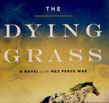 |
 |
03-06-09: Keith Donohue Unleashes 'Angels of Destruction' : The Child is the Mother of the Woman
There's a disease called Charles Bonnet Syndrome that strikes those who have suffered from visual impairments due to old age, eye damage or macular degeneration. Because the brain is used to input, lots of input, from the optic nerves, once those nerves stop sending detailed, voluminous visual information, sufferers from Bonnet Syndrome will manufacture input in the form of complex and detailed hallucinations. Humans, it seems, have a natural need to fill the holes in their lives.
So what happens when humans lose a child? When a child runs away, never to return? Keith Donohue, who wrote 'The Stolen Child', offers readers a lush, multi-layered vision of the ineffable that fills in the lacunae left when child runs away in 'Angels of Destruction' (Shaye Areheart / Crown / Random House ; March 3, 2009 ; $24). Donohue's vision is indeed a complex, beautiful written hallucination that wraps itself around the reader's heart with a feathery but chilling touch.
As the novel begins, Margaret Quinn is an old woman, a widower living alone in the chilly northeast. In the hour of the wolf, she awakens to hear a tap on her door. It's Norah, a nine-year old girl, seeking shelter — and providing shelter as well. It's been almost 30 years since Margaret's own daughter ran away. Margaret takes Norah in, and the world unravels around the reader.
Donohue is a masterful writer on a variety of levels. As Norah insinuates herself into Margaret's world, we explore not only the mystery of Norah herself, but that of Margaret and what transpired with her daughter, Erica. For Margaret, Norah is like the visions created by Bonnet Syndrome when vision itself departs. But just who she is and why she is in Margaret's world are fascinating mysteries that also need knowing, even if knowing may seem impossible.
The joy of Donohue's second novel is not simply in his clever and complex plotting but also in his impeccable prose. Every sentence is a dislocating vision, every word takes readers another step from reality as we know to the inner worlds of characters and an outer, larger world we cannot possibly comprehend. Donohue is in many ways the truest heir yet to the Lovecraftian imperative to suggest the outlines of the unreal and let the reader fill in the details. His sentences have an almost cruel, cold beauty and precision about them. His writing frees the unease at the heart of what we do not and cannot know or admit about ourselves. We lie to ourselves as easily as we lie to others. We create visions where there is nothing to see.
|
|
03-05-09: Subterranean Press Sings 'Songs of the Dying Earth' : Stories in Honor of Jack Vance
Books mark us. We read, and something happens not just in our minds — the reading experience — but to our minds as well. Philip K. Dick's short story, "We Can Remember It For You Wholesale" is a perfect science fictional vision of the reading experience as implanted vacation memories. Science fiction readers in particular are fortunate to get such vivid vistas poured directly into our minds. And some of the most vivid visions I've ever experienced are those of the Dying Earth, courtesy Jack Vance. Yes, I still have piles of ugly yellow-spined DAW paperbacks in the garage, but more importantly, I can poke around the many worlds and wonders Vance unfurled in my mind as read about Cugel the Clever. Vance's brand of science fantasy achieves something very difficult for science fiction; it's timeless.
I'm not the only one who was imprinted by Jack Vance. Just take a look at the must-buy anthology 'Songs of the Dying Earth: Stories in Honor of Jack Vance' (Subterranean Press ; September 30, 2009 ; $40), edited by the superstar duet of George R. R. Martin and Gardner Dozois. The list of contributors is nothing short of astonishing to readers of this column. You've got a new novella by Dan Simmons — he's one busy guy — as well as all-original stories by Jeff VanderMeer, Matthew Hughes (of course!), Neil Gaiman, Kage Baker, Howard Waldrop, George R. R. Martin (doing double duty), Liz Williams, Tad Williams, Walter Jon Williams, (it's like a supermarket special on Williams), Lucius Shepard, Glen Cook, Elizabeth Hand, Elizabeth Moon (apparently Elizabeth Williams was busy), Tanith Lee, John C. Wright, Robert Silverberg, Terry Dowling, Mike Resnick, Paula Volsky, Byron Tetrick, and Phyllis Eisentein (phew!), with an introduction by Dean R. Koontz and a Prefance by the Man Himself, Jack Vance. I don’t think I missed anybody.
If the list doesn't make this clear, let me do so; 'Songs of the Dying Earth: Stories in Honor of Jack Vance' is a huge book, running 666 pages in the ARC I have. At $40.00 with all the stories alone it would be a steal, but I have to mention the outstanding illustrations by Tom Kidd. Each story gets its own detailed title-page illustration, and they're gorgeous. The interior book design is also classy, with framed pages. Each story includes an introduction to the author and an afterword by the author. The writers have been careful to preserve the particular flavor of Vance's work, that combination of humor, horror, and unbound imagination that forced the critics to come up with the appellation "Science fantasy" to describe it. Any way you look at it, Songs of the Dying Earth: Stories in Honor of Jack Vance' is a total steal. But for all the quantity and quality on parade here, there's one simple reason to buy this book. It will mark you. These writers have remembered Jack Vance for you — wholesale.
|
|
03-04-09: Colson Whitehead Returns to 'Sag Harbor' : Wish We Were Then
There's more than one way to get the hell away from the troubles of this very day. Invented and fantasy worlds can take us out of ourselves and offer a new perspective. But the point of great writing is that you can experience another person's life in words; and it's a good idea to choose that life, those words carefully. Because it's not just the life that matters, it’s the approach. In 'Sag Harbor' (Doubleday / Random House ; April 28, 2009 ; $24.95), Colson Whitehead takes readers back to 1985 and displays a peerless sense of taste. If you spent your 1980's with your nose in Fangoria Magazine, trying to find out the make secrets behind Freddy Krueger, then you definitely want to spend some quality time in the 21st century reading 'Sag Harbor'.
It helps to have a sense of humor about yourself. Colson Whitehead's memorable non-memoir 'Sag Harbor' is first and foremost, very, very funny. It's quite a few other things as well — immersive, intelligently-written and insightful. But the perspective it provides, the insight it offers, is that it is OK to look at yourself and laugh. That perception alone can turn the world around.
Whitehead himself (in that dryly humorous ARC blurb) calls 'Sag Harbor' his, "Autobiographical Fourth Novel, as opposed to the standard Autobiographical First Novel." He tells us on the front of the advance reading copy that, "The people are made up, but the houses are all real." So you now know, going in, that you're getting a slice of life, in this case, in the 1980's. Benji Cooper is oine of just a few black students at a hoity-toity prep school in Manhattan. But being black is what makes him stand out so much as being the sort of kid who reads Fangoria. That proves to be a social faux-pas from which there is no recovery, but it's exactly the thing that will seal his appeal to readers of this column. Of course, the fact that his hair is a misshapen lump of something awkwardly attached to his skull doesn't help. The only thing that makes life bearable for those in these straits is the ability to put sharp words in a bow, then aim, draw and shoot with unerring accuracy, time after time. In a series of sentences, a life that might have seemed non-descript is transformed into a rocking good time for anyone who groks the English language.
It helps a lot if you "grok" as opposed to "understand" or "get it." You see, Benji's what we would now affectionately call a "geek," a term I'm not fond of, because generally those who use it but are not it really seem to have some nose-lookin'-down going on. But, like, whatever. It's 1985, and Benji's the guy, like us, who listens to Siouxsie and the Banshees while he's playing Dungeons and Dragons. This does not endear him to the general populace of his prep school or indeed the world at large. It might not even endear him to readers were it not for Whitehead/Cooper's wicked sense of humor and mind-blowing skills with the English language. Benji and his cadre of friends are nothing less than a total hoot to be around. 'Sag Harbor' makes the time slip away in three fashions; it transports you to the time in your life when it was difficult to be in your own skin — no matter what sort of skin or what period of history, those hurts and joys are universal; it takes you back to 1985 with a detailed sense of time and place — and it takes you away from this world while you're reading it. This day, so what? And, for what it's worth, Siouxsie and the Banshees are still touring. Who says you can't go home again?
|
|
03-03-09: Carolyn Turgeon Wants to Introduce You to Her 'Godmother' : A New York Fairy Tale
Anybody who reads this column regularly probably knows the employees at their local independent bookstores. But how well? Carolyn Turgeon imagines in 'Godmother' (Three Rivers Press / Crown / Random House ; March 10, 2009 ; $13.95) that there's quite a bit we may not know about the employees of our favorite local bookstores.
In the opening pages of 'Godmother', readers meet Lil, an old woman who works in a used bookstore. Readers will recognize themselves in the character, just the first of many clever turns by the author. Lil loves the smell of old books — don’t we all? Especially in bookstores. And as well, Lil loves the whole "Found" Magazine aspect of books, those little notes that sometimes drop out, grocery lists of ancient "I love you" messages. It's a pretty good gamble that people who read books will like to read about other people who like books as much as said readers. And that they'll empathize with booksellers. With careful, lush language and evocative prose, Turgeon puts readers in the first-person perspective of Lil with complete confidence.
Of course, it turns out that Lil has wings.
And no, thank whatever bearded deity you happen to impose on a cloudy sky, she's not an angel. She's a Fairy Godmother with a shameful past. It's the Godmother aspect that gets her the huge feathered wings; otherwise, she might be ready to apply for a supporting role in the NY Opera version of David Cronenburg's The Fly — because most fairies apparently have insect wings. And the shameful past, well, it has to do with a lass named Cinderella, and the unfortunate role Lil played in the what actually transpired but has been you know, cosmeticized by earlier authors.
Turgeon doesn't play her fairytale New York for laughs. Instead she immerses readers in a sensual, visceral world that happens to include a variety of magical creatures which she renders as believable characters. Once the fairies are real, they can complicate the plot in ways that humans cannot, which allows Turgeon the opportunity to play with plot imagery and characters in a rather unique manner. She can have fun with a purpose, use the fantasy tropes to tell us not about fantasy, but about reality. She manages to do this while telling two stories in the space generally allotted to one.
Readers will have to be on their toes to find 'Godmother.' It's a trade paperback original with a rather bland cover that's not likely to get shelved with genre fiction and not likely to be noticed with literary fiction. It belongs on both sets of shelves, really, which is verboten in today's bookselling climate. It's worth the search (and you should look for it at your local independent — I mean, the main character does work at an independent bookstore!), no matter what your literary inclinations are. It has the surreal aspects of the best genre fiction and the literary chops to appeal to a much wider crowd. It's certainly fun, and moreover one of those books that is guaranteed to change the way readers perceive the world. You'll never look at your bookseller in the same light.
|
|
03-02-09: Peter V. Brett Tattoos 'The Warded Man' : Demonic Fantasy First Book
We must pay for our art, and the cover price tag is the least we can offer. Consider those who create; it is not an easy choice to pursue a passion and put it into words. The toll such an obsession takes is beyond accounting. Indeed, one can only make an approximation with the words a writer puts on the page. The better the writing, the greater the cost to the writer, a cost that is so often invisible.
Given that we're staring down what could be a prototypical template fantasy, 'The Warded Man' evades our expectations in a number of pleasing manners. Oh sure, we've got the three young protagonists who come together as if their fate were set by a cunning writer of genre fiction. And we've got a world where magic of some sort is in play and the leaders tend be called "Duke" and not "President." We've got hints that this is like, the third age of man, and there are shadows of post-post-science fiction Apocalypse. None of this is exactly new, and in that sense, there's an initial comfort level established for those who find Peter Brett filed in the same shelves with cover-blurber Terry Brooks. So we're not looking at a total re-invention in 'The Warded Man.'
But we are looking at some rather fine writing, the sort of detailed, enjoyable prose that sucks this world away and replaces it not with something not necessarily better, per se, but certainly something more exciting. In 'The Warded Man', humanity survives as it can during the day because at night, the demons, or "corelings" come out. Think your scaly, satanic, draongy, human-esque, sharp-fanged, slathering monsters and you'll get most of the way there. Brett's superior prose will take you the rest of the way. Now, in Brett's scenario, there's just one reason these critters don't just gobble up all the humans, and these are the wards, written symbols which look strikingly like runes. (At this point I send you briefly to Brett's website, where you can see lots and lots more wards, and other stuff associated with the book.) You get good enough writing (and erasing at the appropriate time) these wards, you can slice a sand demon in half like hot knife cutting through butter, only it doesn't smell as good. Do note, however, that Brett's got more than just sand demons up his sleeve. I love a good set of entertainingly conceived monsters.
Obviously, it's not hard to see where this is going. You got your runes, er wards, you got your demons, and maybe ... you've got a needle, paint and a high-tolerance for pain. Of course, the next time a sand demon sees you coming, it may just explode all over you (or not), and sure, that's nasty if it happens, but consider the alternative. Brett doesn't play this for humor though, he takes his world and his characters seriously. He's got a great knack for layering character and graphic action, playing up the thriller, so to speak, aspects of the fantasy genre while focusing on creating complex characters who are enjoyable to be around, enough so that you may find yourself ordering the UK version of the sequel, 'The Desert Spear,' when it arrives in hardcover this August. Do our stateside booksellers and publishers a favor and at least spring the for US version when it shows up. And just think about the ancillary merchandise markets for this book — demon figures, temporary warding tats — there's no reason that books can't generate the kind of cash flow and marketing plan that one finds with movies. And, at this point, they can't charge you admission to read the book a second time. Paper has not yet refused ink, just as nobody's managed to keep the words in books out of any reading eyes.
|
|
 |
|
|
|




